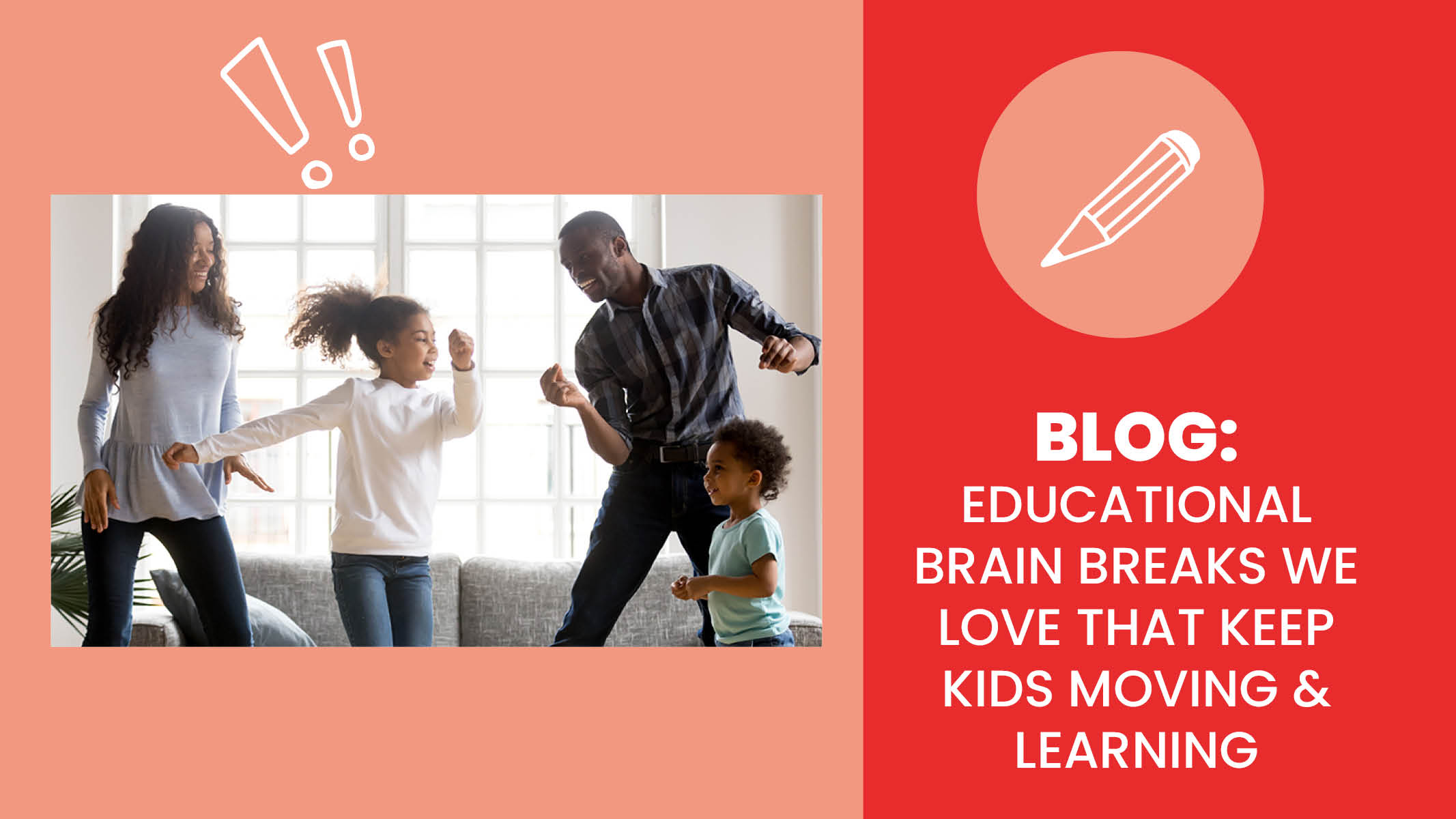Brain breaks are planned mental breaks or movement activities designed to get more blood and oxygen moving to the brain. That boost can give kids an advantage in learning and creativity. Why? According to a 2021 study from the National Institutes of Health, researchers discovered that our brains may replay compressed memories of learning new skills when we rest. Using planned breaks as part of a learning routine may be a powerful tool that can help kids learn skills faster.
This concept of a mental reset isn’t limited to the classroom, though – it extends to the playing field as well. To better understand the importance of taking breaks, we spoke with Anthony Morando, General Manager of Sports Performance at Sanford Sports. "Time away from a specific space is a good mental reset," says Morando. In his field, he uses mental resets as an effective stress management technique, helping athletes recover from both physical and mental fatigue.
According to the American Academy of Pediatrics (AAP), meditation and relaxation have physical benefits as they calm the nervous system and decrease stress hormones. Brain breaks that are active, movement-based activities can promote increased oxygen to the heart and lungs, which encourages blood flow throughout the body. Numerous studies have also shown that bouts of physical activity can keep children on-task, focused, and offer other health benefits like:
- Improved gastrointestinal health
- Fewer headaches and reduced frustration
- Lowered blood pressure and pain sensitivity
- Increased immune function
We talked to Dr. Kristen Ford, an expert in health and physical education at Concordia College and co-founder of SchoolsAlive! alongside Dr. Jenny Linker, professor of physical education at North Dakota State University, about how we can use brain breaks to give our minds and bodies a much-needed energy bump.
“Brain breaks invigorate the body and mind. Even just five minutes will increase your heart rate, get the blood flowing, and promote mental focus. When people move, their heart rate increases, and it gets their blood flowing. This movement encourages more oxygen to travel to the brain and helps students learn because they are more alert, able to focus, and ready to learn,” says Ford.
Incorporating educational content into your brain boosts is a great way to help your child activate their mind even more. Adding content into your breaks can be as easy as playing trivia with class material or doing a jumping jack for every answer your child gives. Based on a 2024 study, not moving enough can make learning harder. This is especially important because more children and teenagers are struggling with learning difficulties. Because of this, it’s becoming more important to include activities that help both the brain and body in school routines. According to Dr. Ford, even walking around or marching in place can help increase your child’s heart rate and boost their brains and energy levels.
Ready to get started for yourself? Try one of these brain break activities at break time to improve focus, boost the brain, and recharge the body's energy:
- Do nothing for two minutes. Don’t underestimate the power of stillness in mental wellbeing.
Have your kids drop everything for a couple of minutes to just sit and relax. Set a timer and let their worries fade away for a couple of minutes. - Make time for a feelings check-in. Feelings are always changing, and that’s okay! Set reminders to have periodic check-ins throughout the day and have your kids use this chart to record how their emotions change! Bonus, they can practice their feelings and emotions vocab with this printable too!
- Enjoy a mo‘mint’. Studies suggest peppermint increases mental and physical alertness. Enjoy peppermint candy or gum, take a whiff of peppermint oil, or even take a toothbrushing break. Kids will come back refreshed and ready to go!
- Practice mindfulness. Mindfulness comes in many forms ─ meditation, listening to music, or getting up to enjoy a snack. Use our Mindful Moments cards for easy ways to practice mindfulness at home or school. Taking the time to act intentionally helps kids' minds recharge and encourages them to indulge in small moments during their day. For more ideas on ways to practice mindfulness, click here.
- Warm hand warm-ups. Can you sense when an afternoon slump on its way either at home or in the classroom? Stop it in its tracks with this easy activity to recharge kids' bodies and brains. Have kids rub their hands together until their hands feel warm, then close their eyes, and place their hands over their eyes. Be sure they take deep breaths to boost their brain recharge!
- Try an ASMR video. Find short clips based on the kids' interests from a kid-friendly or adult-supervised streaming channel. The sensations that can occur from ASMR (autonomous sensory meridian response) can be naturally soothing and mimic responses that newborns experience when being soothed by a caregiver. There are endless video possibilities, from underwater sounds to soap cutting and slime noises!
- Check out this movement activity.

- Act it out. Give kids different scenarios to act out. How many can they do in 3 minutes? Start with an activity like driving a car, grocery shopping, or blowing bubbles.
- Say Cheese: Have kids close their eyes, relax their face, and tuck their chin down. Then, have them slowly start to smile, starting with a small smile and working their way up to the biggest smile they can do. As their smile goes, have them lift their head and open their eyes so they end with a huge smile while they look at the sky.
- Use our fitBoost activity to get your body moving! Get active for a few minutes and get the family or class in on the fun. Pair the activity with our fitBoost cards. All you need is a quick break to get your move on before you get back to the day!
- Get up and stretch out. Stretching is a great way to get the blood moving in the body since movement encourages more oxygen to the brain and increases kids’ ability to focus. Have kids hop up from their desk and touch their toes or pull one card from this free Single Yoga Pose deck. For multiple stretches or poses, do a quick yoga flow.
- Take a dance break. Put on your favorite song or playlist and dance it out! To make it a game, when the music stops, freeze in a crazy pose until the music starts again! Looking for a kid-friendly playlist? Check out our fit Music Playlist for some high-energy songs that encourage healthy choices!
- Practice that positive self-talk. Grab a crayon or colored pencil and let their creativity flow while practicing positive self-talk! These free coloring pages are full of affirmations to add a little extra positivity to their life. Hang them in the home or classroom for an ongoing, positive reminder!
- Make a brain break spinner. One way to make sure educational brain breaks are effective is to change up activities. Check out this step-by-step video to learn more about how to make your own to help you add variety to brain breaks!
- Clap on, clap off. This activity is a fun way to get your kids’ minds focused quickly. When you say “clap on,” kids clap their hands vigorously together. When you say “clap off,” they stop as quickly as they can and freeze.
- Try some facial gymnastics!
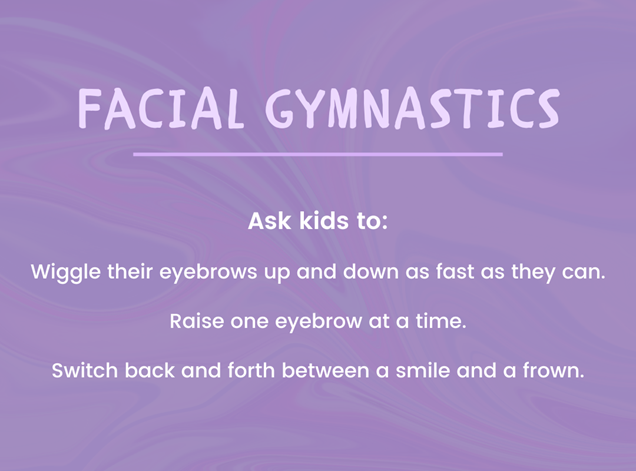
- Cardio desk drumming. This is one of the best ways to keep kids at their desks and it can be easily done in the car, too! Have them use their hands or markers as their drumsticks and follow along with one of our favorite teachers that shows a simple, steady drumming routine for Believer.
- Puzzle time! Give your kids a fun activity sheet, like this printable word puzzle, and let them crack the codes!
- Create a Take a Break Basket. Give your kids the power of choice and have them create their own Take a Break Basket. Fill it with coloring pages, chapter books, or challenge cards and let the kids choose how they want to spend their brain break.
- Just Imagine! Sometimes kids need to bounce or shake their energy out. Have them pretend they are bouncing on a mini-trampoline or that they’re in a snow globe. This will keep their movement contained instead of all over the room while still giving them a couple of minutes to let loose!
- Make it rain. Conjure up a rainstorm with our Brain Rain Relaxation Activity! It’s a great, equipment-free activity to use when your kids need to relax. All they need are their hands and some imagination!
- Grab a dice and chat.
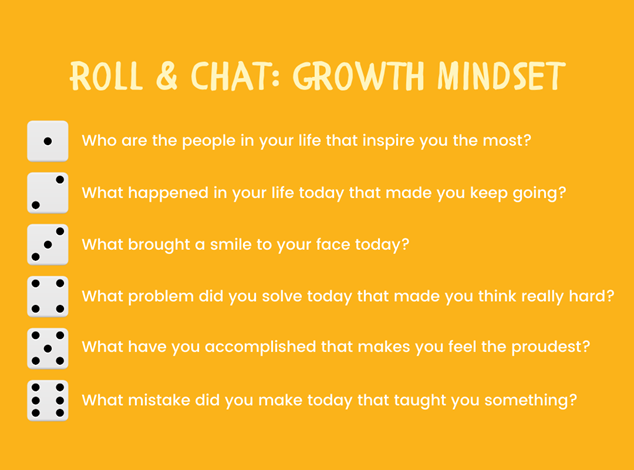
- Rub their belly and pat their head. This is a classic activity that’s a little tricky! Encourage your kids to try it out and don’t forget to switch hands or directions for an extra challenge.
- Practice a breathing exercise. Different kinds of breathing can help you and your kids relax and increase mindfulness. Making healthy choices is as easy as pausing to take a deep breath!
- Tongue twister time! Tongue twisters are a great way to build literacy skills and have fun doing it. Try it together as a group! Here's one of our favorites:
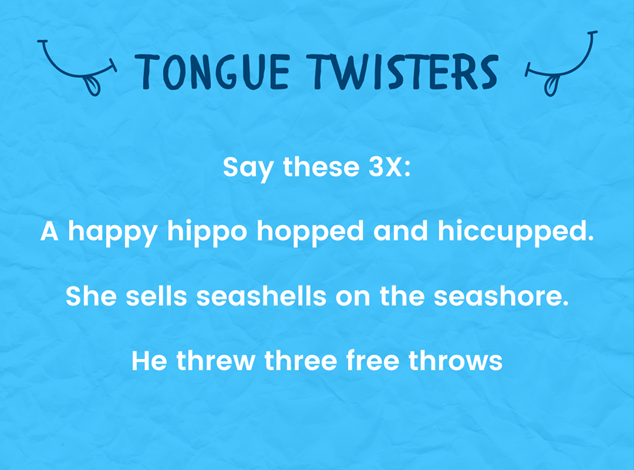
- Sensory bin fun! This is a great activity for kids with sensory needs. Use something like rice or dried beans in large buckets, then fill it with special items like scoops, spoons, measuring cups, small toys, or even funnels. Change out the special items to keep it fresh and fun!
- Enjoy a mindfulness meditation. This awesome guided meditation can help your kids practice being mindful or give them a moment of peace.
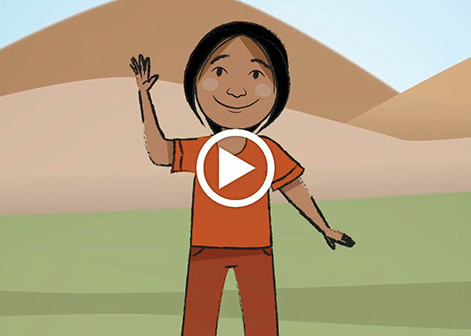
- Fast Finds: Call out a color, material, or shape. Kids have to find something that matches whatever you chose and get back to their seats as fast as they can. Share what they found!
- Take a trip through the Sensory Path! These color-coded posters are perfect for a hallway movement break or a sensory path in your classroom. This free poster set will take your kids through a different set of tasks to help them move their bodies, recharge their minds, think about their food and drink choices, and motivate their mood!
- Animal Alphabet: This activity is a great way to test your students' memories. Sing the alphabet with the names of animals, rather than the letters!
- Play a round of Animal Charades.
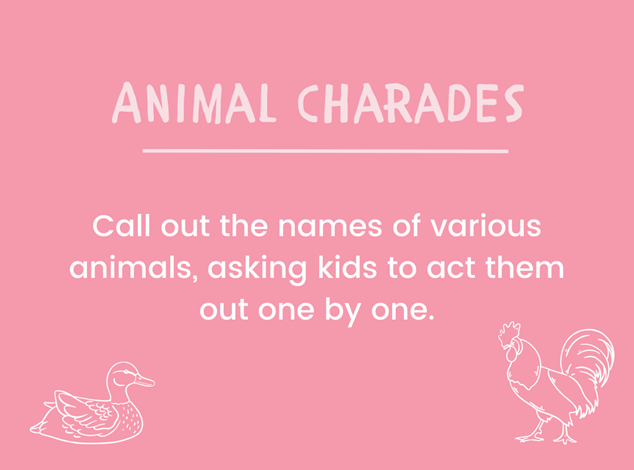
- Dragon Breathing: Have kids sit or kneel and close their eyes. With their mouth closed, breathe in slowly through their nose for an 8 count. Hold their breath for a 2 count, and open their mouth wide and stick their tongue out as they exhale for a 5 count.
- MOVE Bingo: Our MOVE Bingo resource is a fun, active brain break where kids complete different movement tasks. It boosts circulation and oxygen flow to the brain, helping students refresh and refocus. It provides an engaging way to recharge both the body and mind, making it an ideal break for maintaining focus and energy in the classroom.
- Superhero Power Stance: Have students stand in a "superhero" pose with legs apart, hands on hips, and chests puffed out. Hold the pose for 30 seconds to 1 minute while they focus on their breathing and imagine themselves with superhero-like focus and strength. This power pose boosts confidence, stimulates positive thinking, and helps students mentally reset.
- Mirror Movements: Pair students up and have one student perform simple movements (like raising arms, jumping, stretching, etc.), while the other student mirrors them exactly. Switch roles after a minute or two. This encourages focus and coordination, activating the brain through both observation and physical movement.
Regardless of which brain break you choose, these planned breaks can help improve focus, reduce boredom, and restore energy to resume learning tasks. To make the most of the breaks, try planning them out for the day as part of your transitions between subjects or activities, as part of content review or as an after-school refresher. Helping kids have the energy and focus they need to learn is vital to being creative and staying healthy. Learning doesn’t stop when you take a brain break, the brain is just working and learning in a different way!
Ready for More? You Might Also Like:
fit Workout: Yoga Flow
Every Day Dance Routine Printable
The Art of Recharging Video
